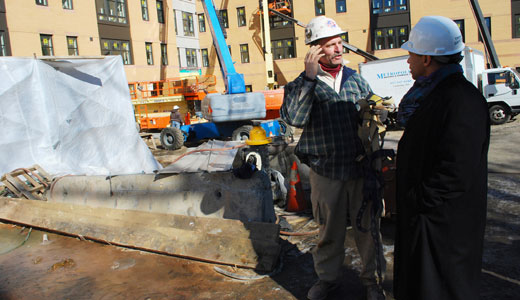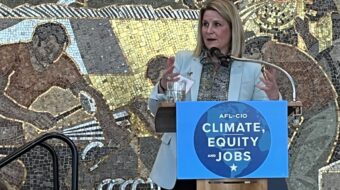
Our country is plagued by a severe jobs crisis. The crisis is on-going and the longer it lasts, the larger the number of permanently unemployed. Failure to maintain and rebuild the country’s infrastructure and housing stock has contributed heavily to the length and number of long-term unemployed. It has been a major factor in the declining quality of life in our country.
In his 1937 second inaugural address President Franklin D. Roosevelt said: “I see one-third of a nation ill-housed, ill-clad, ill-nourished.” He was pointing to the need for a massive national housing program that would both build housing and create jobs to help end the Great Depression. That idea was set aside because of the outbreak of World War II, but there was a promise of post-war housing. To this day, there has never been a meaningful mass affordable housing program. Some public housing was built in such cities as New York, Cleveland, Newark, Chicago, but not nearly enough to meet the housing crisis. The promise of a post-war mass housing program was betrayed.
There is an urgent need to rehouse America. The current housing stock is old, decrepit and dilapidated. The number of housing units lost through fire, flood, neglect, age and landlord greed far outpaces the construction of mass affordable housing. In large measure the crisis is a product of capitalist control of the land and housing stock of our country. Thus, it will be a difficult struggle to launch a massive and inclusive housing program.
Housing is a basic human right, as well as a survival necessity. Homelessness continues to grow, including among military veterans. Much of the homelessness is invisible – you don’t see the doubling and tripling up of families. The cruelty of homelessness is so severe that one of the main activities of Pope Francis is working among the homeless.
Adding to the anguish is the mortgage swindle perpetrated by the Wall Street banking houses through which they stole homes of millions of homeowners. Adding to the homelessness and overcrowding is the unbridled escalation of rents. This is not only among the poor; it includes higher paid workers as well. A large percentage of homeless people work one and two jobs, but still cannot afford rent.
The housing crisis is both urban and rural.
What is a mass housing program? What do we need?
Here’s a case in point:
In New York City there is a real estate boom. It was fostered by former Mayor Michael Bloomberg. He campaigned for more rich people to move to New York. The real estate boom is in the condominium market. The price range for these condos is $9 million to $30 million. This is not a real estate boom for the people. It is more of the current process of the rich enjoying the spoils.
In contrast, in Richmond, Calif., Mayor Gayle McLaugllin is using the power of eminent domain to use city funds to buy up houses with mortgages that are “under water” (where the mortgage that the owner owes is more than the current value of the house). McLaughlin’s policy would prevent banks from foreclosing on these homes. The city would then restructure individual mortgages and keep the homeowners in their homes.
A national housing program to meet the housing needs of the urban, suburban and rural sectors of our country is in fact a foundation of building economic and social prosperity. A massive housing program meeting particular needs of each sector requires full participation of all skills and crafts, of architecture and engineering, of unions, community groups and organizations, and of new non-monopoly banking sources. Every housing unit that is built also requires the production of home furnishings, streets, gas and electric supply, sewers, schools, health care facilities, parks, stores, etc. In other words, you can’t do it alone – it takes a whole community to build a new community.
What kind of housing does our country need? We need all kinds of housing – we need quality, affordable high-rise housing; we need low-profile garden developments; we need affordable single-family houses; we need housing in rural communities.
Clearly President Obama’s American Jobs Act can be an integral part of this program. We are not starting from scratch. All over the country, struggles are being waged by people’s organizations for new housing. But every local area and state needs to develop a concrete program to meet today’s housing needs and also plans for the future.
How do we pay for this? The ultra-right says the government is broke. Is this true? The truth is, the government has been pumping $85 billion a month to bail out Wall Street since 2008. That’s a trillion dollars a year. There is always money for Wall Street.
The banking system is so bloated that the government just recently cut Wall Street’s welfare check to $75 billion a month. Clearly that $10 billion per month can begin to finance a national housing recovery program. This money can be handled by a national reconstruction bank as proposed in a bill filed by Congresswoman Rosa DeLauro, D-Conn., and discussed by President Obama in his 2013 State of the Union message.
Can we achieve a national housing program? After Hitler’s dive bombers leveled the cities and towns of Europe in World War II, they were all rebuilt after the war. We can rebuild our cities. But to achieve this we need a massive movement. The money is there – the Wall Street welfare, closing the tax loopholes for corporations that allow the major corporations to pay little or no taxes, realizing the peace dividend by transferring military spending to housing and jobs programs, and increased revenues through job recovery.
Photo: Massachusetts Gov. Deval Patrick visits construction of the new Washington-Beech housing development in Roslindale, a Boston neighborhood, in 2010. Deval Patrick CC 2.0












Comments